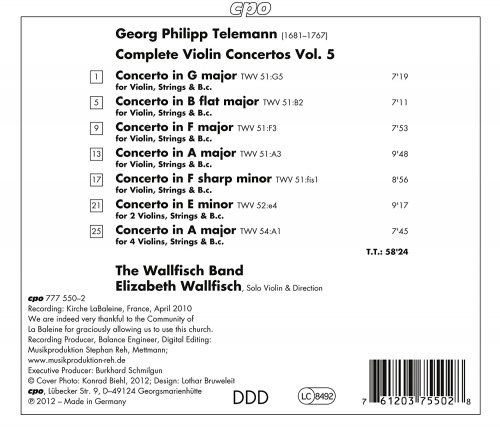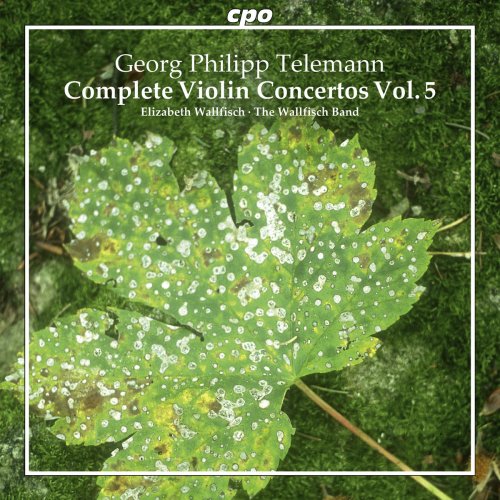
Elizabeth Wallfisch - Telemann: Complete Violin Concertos, Vol. 5 (2012)
BAND/ARTIST: Elizabeth Wallfisch
- Title: Telemann: Complete Violin Concertos, Vol. 5
- Year Of Release: 2012
- Label: CPO
- Genre: Classical
- Quality: FLAC (tracks+booklet)
- Total Time: 58:09 min
- Total Size: 356 MB
- WebSite: Album Preview

Tracklist:
01. Violin Concerto in G Major, TWV 51:G5: I. Andante
02. Violin Concerto in G Major, TWV 51:G5: II. Molto Allegro
03. Violin Concerto in G Major, TWV 51:G5: III. Grave
04. Violin Concerto in G Major, TWV 51:G5: IV. Vivace
05. Violin Concerto in B-Flat Major, TWV 51:B2: I. Adagio
06. Violin Concerto in B-Flat Major, TWV 51:B2: II. Allegro
07. Violin Concerto in B-Flat Major, TWV 51:B2: III. Grave
08. Violin Concerto in B-Flat Major, TWV 51:B2: IV. Allegro
09. Violin Concerto in F Major, TWV 51:F3: I. Adagio
10. Violin Concerto in F Major, TWV 51:F3: II. Allegro
11. Violin Concerto in F Major, TWV 51:F3: III. Adagio
12. Violin Concerto in F Major, TWV 51:F3: IV. —
13. Violin Concerto in A Major, TWV 51:A3: I. Grave
14. Violin Concerto in A Major, TWV 51:A3: II. Vivace
15. Violin Concerto in A Major, TWV 51:A3: III. Adagio
16. Violin Concerto in A Major, TWV 51:A3: IV. Allegro
17. Violin Concerto in F-Sharp Minor, TWV 51:fis1: I. Adagio
18. Violin Concerto in F-Sharp Minor, TWV 51:fis1: II. Allegro
19. Violin Concerto in F-Sharp Minor, TWV 51:fis1: III. Adagio
20. Violin Concerto in F-Sharp Minor, TWV 51:fis1: IV. Allegro
21. Concerto for 2 violins in E Minor, TWV 52:e4: I. Andante
22. Concerto for 2 violins in E Minor, TWV 52:e4: II. Allegro
23. Concerto for 2 violins in E Minor, TWV 52:e4: III. Adagio
24. Concerto for 2 violins in E Minor, TWV 52:e4: IV. Vivace
25. Concerto for 4 Violins in A Major, TWV 54:A1: I. Affettuoso
26. Concerto for 4 Violins in A Major, TWV 54:A1: II. Allegro
27. Concerto for 4 Violins in A Major, TWV 54:A1: III. Adagio
28. Concerto for 4 Violins in A Major, TWV 54:A1: IV. Allegro
The notes to Volume 5 of violinist and conductor Elizabeth Wallfisch’s collection of “Complete Violin Concertos” by Georg Philipp Telemann explain that all these works come from an early period in the composer’s production, in which he tried to break free from the Italian influence (thus, perhaps, the unvarying four-movement pattern of these works). Still, Vivaldi’s energy, channeled by typical Italian violin figuration, reappears in the Molto allegro of the Concerto in G Major, TWV 51:G5. Arcangelo Corelli’s sequences appear in the finale of that concerto, but the passages bounce with a helium-like buoyancy worlds removed from Corelli’s more stately elegance. The Concerto in Bb-Major, TWV 51:B2, begins with a slow movement that integrates the solo into the ensemble in a way that’s more Corellian than Vivaldian—but seems essentially Telemann’s own invention. The Concerto in F Major, TWV 51:F3, drapes a flowing violin solo over a bustling near-ostinato motive that maintains a lively demeanor throughout the movement. As the ensuing Allegro shows, Telemann’s idea of a concerto soloist, especially in the fast movements (and even in the slow ones) differs markedly from that of Vivaldi and Bach, allowing the solos to emerge from the texture as Corelli did in his Concerti grossi, op. 6, or Giuseppe Torelli did even in his solo concertos. That’s not to say that the works seem soporific from the violinistic point of view: The concerto’s finale, with its brusque, ruddy energy, never allows a listener’s attention to wander, even if the violinist isn’t spinning technical fantasies in the manner of Pietro Locatelli or Jean-Marie Leclair. In the Concerto in A Major, TWV 51: A3, Wallfisch and her ensemble effectively employ dynamic contrasts to create a bracing atmosphere. Here, as elsewhere, Wallfisch rises to a high soloistic profile when the music demands it—it’s clear from passages like these that she sinks the individual, when she does, for musical reasons rather than for any natural reticence or idea of soloistic integration. She and the ensemble play the chords in the brief, almost purely transitional, Adagio with attention-garnering freshness. In the finale, she once again strikes a more virtuosic attitude. The Concerto in F# Minor may be cast in an unusual key, but it’s hardly crabbed; and Wallfisch makes the double-stops of its slow movement sound at once mellifluous and commanding. Still, she’s able to lower her profile in the contrapuntal finale.
The collection includes two concertos for multiple soloists. The first of these, the Concerto in E Minor for Two Violins, TWV 52:E4, blends the soloists seamlessly in the first movement. In this work, violinist Evan Few joins Wallfisch. They don’t engage in the second movement in simple parallel motion, as Torelli might lead them in a similarly crafted work; but they do alternate passages in which they answer each other with others in which they run side-by-side. In the Concerto for Four Violins in A Major, TWV 54:A1, violinists Gabrielle Wunsch and Susan Carpenter Jacobs join Wallfisch. If, as Wolfgang Hirschmann’s notes point out, the textures hardly suggest a concerto for four soloists (with two of them melded into the orchestral texture), the resulting sonorities still seem rich and thick in this performance.
If every one of these concertos might strike listeners as a candidate for the standard repertoire, not one of them has yet entered it. Perhaps this release may start the process of admission. Like the earlier volumes in the series, this fifth volume deserves a heartfelt commendation.
The collection includes two concertos for multiple soloists. The first of these, the Concerto in E Minor for Two Violins, TWV 52:E4, blends the soloists seamlessly in the first movement. In this work, violinist Evan Few joins Wallfisch. They don’t engage in the second movement in simple parallel motion, as Torelli might lead them in a similarly crafted work; but they do alternate passages in which they answer each other with others in which they run side-by-side. In the Concerto for Four Violins in A Major, TWV 54:A1, violinists Gabrielle Wunsch and Susan Carpenter Jacobs join Wallfisch. If, as Wolfgang Hirschmann’s notes point out, the textures hardly suggest a concerto for four soloists (with two of them melded into the orchestral texture), the resulting sonorities still seem rich and thick in this performance.
If every one of these concertos might strike listeners as a candidate for the standard repertoire, not one of them has yet entered it. Perhaps this release may start the process of admission. Like the earlier volumes in the series, this fifth volume deserves a heartfelt commendation.
As a ISRA.CLOUD's PREMIUM member you will have the following benefits:
- Unlimited high speed downloads
- Download directly without waiting time
- Unlimited parallel downloads
- Support for download accelerators
- No advertising
- Resume broken downloads


